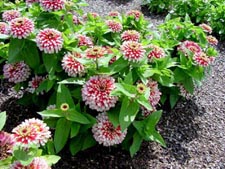 |
| Consider marigolds and zinnias for late-summer and fall bedding plants.
This swizzle cherry and ivory zinnia has done well in LSU AgCenter trials. |
August 2005 We usually associate warm-season bedding plants with the spring and summer
growing seasons. Many of these plants, however, actually do better from
mid- and late summer through the fall, according to
LSU AgCenter
horticulturist Dr. Allen Owings.
This phenomenon is especially true in the lower portions of USDA
hardiness zone 8 and
throughout zone 9. Zinnias and marigolds are two excellent examples
of warm-season bedding plants to try from August through the first
killing frost.
"Marigolds are a great fall blooming plant," Owings says, adding,
"They produce bold colors and striking flowers and are great for fall
landscape displays."
The horticulturist notes that Texas A&M University began recommending
marigolds for the fall as a replacement for garden mums about 10-15
years ago, and this is now beginning to catch on with landscapers and
home gardeners.
Many marigold plantings in the late summer and fall will actually
outperform a spring planting in terms of "lasting in the landscape."
Most spring-planted marigolds usually decline considerably in south
Louisiana by June because of petal blight, stem lodging (African
cultivars) and spider mites. An August planting typically does not
experience the flower disease because of the drier fall weather.
Also, there are fewer spider mite problems this time of the year.
Marigolds come in a wide range of varieties. African marigolds are
taller, larger, cut-flower type of varieties. Primary colors are
orange, gold and yellow. Examples include the Inca II, Perfection and
Antigua series.
French marigolds are the shorter, smaller-flowered types and include
the Hero, Bolero, Bonanza, Janie, Durango and other series. More
color variation is available in the French varieties. There are also
hybrid marigolds.
Zinnias have a few disease problems – primarily leaf spots (caused by
fungus and bacteria), flower/petal blight and powdery mildew. Like
marigolds, these problems can be greatly reduced, and plant
performance can be improved in a late summer and fall planting
compared to a spring planting.
Many zinnia species are available. Traditional, older zinnia
varieties are the Zinnia elegans varieties. Some of these varieties
are good for cut flowers, like the Benary Giant series.
Other varieties are better as short bedding plants, such as the
Dreamland series. A wide range of flower colors is available in these
zinnias. The new Swizzle series of zinnias have performed well in LSU
AgCenter trials. The Magellan series shows promise, too. The new
Zowie! Yellow Flame zinnia is an All-America Selection for 2006.
Other popular zinnia groups are the narrowleaf zinnias (Zinnia
linearis or Zinnia angustifolia) that include the Crystal and Star
series. Flower colors available in these are gold, orange and white.
The newest zinnia group is a cross between the narrowleaf zinnias and
the older zinnia varieties. These are hybrids and include the
Profusion series. Available flower colors are white, orange, cherry,
fire and apricot. Some of these are AAS winners.
"Zinnias and marigolds need less care and provide great satisfaction
in the landscape as the long hot days of summer fade to cooler
shorter days of fall," Owings says, adding, "Remember that bed
preparation is important, as it is for all bedding plants."
The horticulturist also says to remove old flowers as they fade,
because this will help extend the season significantly. A couple
fungicide applications during the course of the season will also slow
petal blight and foliage diseases.
|